Three: Holiday spam
Martin Beverley, Nick Exford and Alex Blacklock
Campaign details
Brand owner: Hutchinson 3G
Lead agency: Wieden+Kennedy
Brand: Three
Country: United Kingdom
Industry: Call services and accessories, Fixed line providers, General service providers, Internet service providers, Mobile and cell handsets, Mobile providers
Channels used: Cinema, Earned media, buzz, Events and experiential, Games and competitions, Internet - display, Internet - microsites, Magazines - business, trade, Magazines - consumer, Newspapers, Online video, Outdoor, out-of-home, Point-of-purchase, in-store, Print - general, unspecified, Social media, Television
Media budget: 3 - 5 million
Executive summary
This case study describes how British mobile network Three exploited the idea of social-media envy to publicize their free roaming.
To win share from their competitors customers needed a new reason to choose the brand beyond cheap data deals: research revealed category dissatisfaction and a series of 'pain points' that left them feeling ripped off, with one common gripe being expensive roaming charges when they used their phones abroad.
Three boldly challenged the category by allowing customers to use their phones abroad at no extra cost, giving new customers a reason to join and existing customers a reason to stay.
Three uncovered a modern, mobile insight into the way people use their phones – social bragging – which with Three's new offer could get out of hand with social-media feeds being overloaded with clichéd images of sunsets, hot-dog legs, plane wings and cocktails, leading to a social-centric campaign making a playful apology for the '#HolidaySpam crisis' on behalf of Three's customers who were making the most of the generous offer.
Over one million customers have used their phone abroad at no extra cost, the number of people saying the offer was an extremely important reason to join and stay with Three doubled post-campaign and the network reached an all-time-high customer base and market share.
Market background and cultural context
By 2014, Three had grown to over nine million customers to claim 12% share of the mobile-network market (source: Three). Three had established a position as 'the network that was built for the internet' with a focus on data provision. The combination of data deals and low prices relative to the competition had historically pulled in customers.
However, Three were still fourth behind the major network players EE, O2 and Vodafone. By the end of the year the ambition was to grow market share through customer acquisition, as well as building margin. It was a big task for the challenger brand in a competitive market where most customers succumb to inertia and stay with their existing network provider at the end of their contract.
Despite the desire for new customers, we started by looking inwards at our own customers. We conducted research that allowed us to develop a comprehensive segmentation of our customers. It became clear that Three overindexed with tech-savvy, heavy 'internetting' trendsetters. They loved us for our no-limits, all-you-can-eat data deals and low prices. The result was that Three's customer base could be described as relatively low margin and loyalty customers, who were quick to leave for new price deals when their contracts were up. Three's annual churn rate was the worst in the category with average lifetime value below what it needed to be.
We realized that the opportunity for acquisition and retention lay with the mass market, who sought a broader offering and different things from their mobile provider.
In particular, we identified 'sociable enthusiasts' as a core target for acquisition: they are in their mid-twenties to thirties. 95% of them own a smartphone (source: Mindshare) and they are real 'social butterflies' with their finger on the pulse – they are online, chatting and sharing all the time. If we could get them chatting, sharing and thinking more about Three, we could not only grow our customer base but also tap into a powerful source of advocacy.
We also identified a secondary target segment – the 'pragmatic dabblers'. They are 35–55, family-oriented and financially stable. Technology does not sit at the heart of their lives like with trendsetters and sociable enthusiasts, but once a bit of technology proves its use to them, they will use it regularly. Smartphones are increasingly in that bracket, with 73% now owning one (source: Mindshare).
In light of this customer-base analysis, and using lessons from the IPA effectiveness databank, Three decided to make a fundamental shift in strategy. Rather than retaining and acquiring customers based on price, we would retain and acquire customers through the brand. In theory, a brand-led approach could attract higher-value customers and encourage them to stay longer.
Given both the scale of the challenge and the ambition for growth, our 2014 objectives were plentiful and demanding:
- Attract new customers from the mass market to grow customer base and market share.
- Attract new customers with a brand-led (rather than price-led) approach – we needed to find an innovative new point of difference to attract them.
- Reduce churn of existing customers by giving them a compelling reason to stay beyond low prices.
- Increase average margin per customer.
Insight and strategic thinking
Given our objectives, it was clear that we needed to find an innovative new way to differentiate the Three brand. However, in the mobile network category it is hard for brands to differentiate themselves and add true brand value – essentially we are all selling wobbly air.
To help achieve our brand ambition we needed to understand how customers perceived mobile-network brands. Although we had broken down our customer base into segments, we were keen to understand commonalities, rather than differences.
We found that the category as a whole suffers from perception problems and a lack of trust. Mobile networks are lumped in with banks, energy providers and politicians – all pretty much the same and as bad as each other.
Further customer research revealed the reason why mobile networks were held in such low esteem. It was clear that customers felt undervalued, ripped off and opaquely overcharged. They were treated as numbers, not as people.
We delved into these 'pain points' to understand the frustration customers were feeling.
We found many examples of customers feeling like they were being treated unfairly, but one particular pain point that came up again and again was being charged extra for roaming when they were abroad. Only 25% of them used mobile data abroad, with 25% turning their phones off altogether for the duration of their trip (source: Three).
Many customers told first- or second-hand stories of discovering astronomical bills on their return from holidays, often running into thousands of pounds, just for using their phone abroad. Mobile networks were making millions, but many customers were avoiding being stung by keeping their phones off or restricting themselves to using hotel wi-fi.
We decided to adopt a challenger-brand stance to roaming charges – a category convention that every network was guilty of. The 'rules' of the category dictated that customers must incur extra charges for using their phone abroad. But that felt unfair.
So, what if we let customers use their phones abroad at no extra cost? That would be a market first. No other network offered their customers such a deal. But that would also be crazy for the business, wouldn't it?
With further analysis, we decided it could actually work. Sure, we would lose some revenue. However, we hypothesized that we could more than earn it back through existing customers using their phones abroad more, existing customers staying with Three and new customers joining Three to reap the benefits. The improved value for customers being able to 'use their phones abroad at no extra cost' was abundantly clear. We estimated that they could save £97 per trip on average compared to the competition (source: Three).
Ultimately, we believed that being able to use your phone abroad at no extra cost was a strong brand reason to stay with us, endorse us and want to join us. TNS research supported our assertion with our new offer moving us from fourth choice to first in customers' eyes. We could strike a chord with customers by offering them something none of the other networks did.

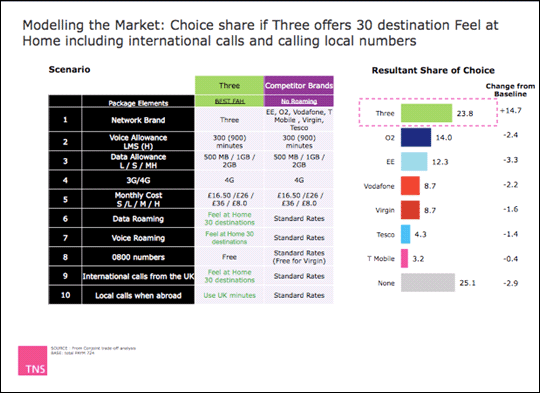
We had a great offer, unmatched by any of our competitors, which solved a common pain point in customers' lives. Now we needed a creative way of bringing this to life for a mass audience.
We started by analysing the initial behaviour of Three customers taking advantage of the offer that became known as 'Feel at Home' – the name was pertinent because customers were using their phones abroad just like they did at home.
Feel at Home meant they could now make a few calls and texts without fear of racking up expensive international charges. But more tellingly, they were using up to 71 times more data than they did before Feel at Home launched (source: Three). Just as we have observed in the UK market over the last few years (source: Ofcom) – where rapidly declining text and call volumes are being replaced by steeply rising data use – Three customers were using their smartphones on holiday to connect to services and with each other through the mobile web.
Sure, they could now make the most of their holiday by using Google Maps to find local attractions, or Trip Advisor to browse local restaurant and hotel reviews. That is all practical, useful stuff. But the main use of data was actually to access social networks. It seemed that even on holiday, people could not resist keeping up with the latest news from their friends and family back home.
In fact, more specifically, customers were really using their data to actively brag about their holidays on social media – sharing an overload of perfectly filtered, prolifically hashtagged, hilariously clichéd images on Facebook, Instagram and Twitter to show everyone back home just how much fun they were having.
It was another example of the modern social phenomenon of people creating an image of themselves through social media. Social-media sites have become plagued with social bragging – everyone wants to appear like they are more successful and having more fun than their friends. It is vitally important to keep up appearances on Facebook, Twitter and Instagram and always be seen to be #winning.
After all, 2014 was officially the year of the 'braggie' on social media (source: Daily Mail), and the best place to brag from was on holiday.
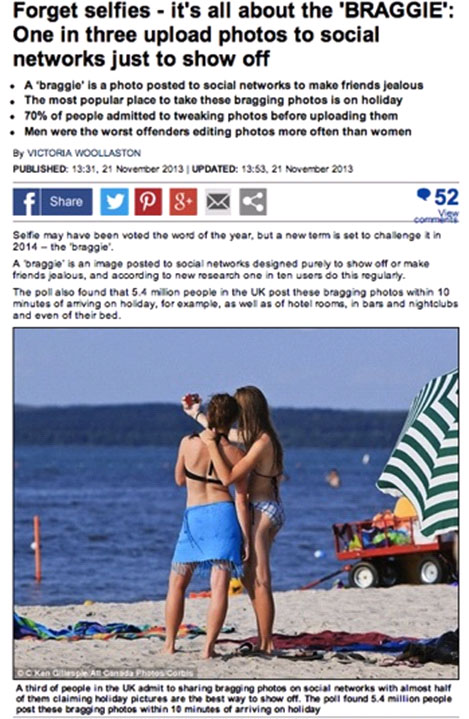
In summary:
- We had an insightful and powerful brand point of difference – being the only network to let customers use their phone abroad at no extra cost.
- We had a mobile-centric, social insight related to our offer – we were fuelling the cultural zeitgeist of holiday bragging on social media.
It was now time to bring it to life in a communications campaign with social at its heart.
Implementation, including creative and media development
We put our social bragging insight at the heart of an integrated campaign which played out in a series of orchestrated phases.
Phase 1: Outbreak
We playfully encouraged our customers to brag on social media about their holidays because they could use their phone abroad at no extra cost. We created a #HolidayBraggie competition to exhibit the best brags. The improved value for customers was clear to see and we fuelled the spread of 'holiday spam' so that we had a wealth of user-generated content to help us with the second phase of our campaign.
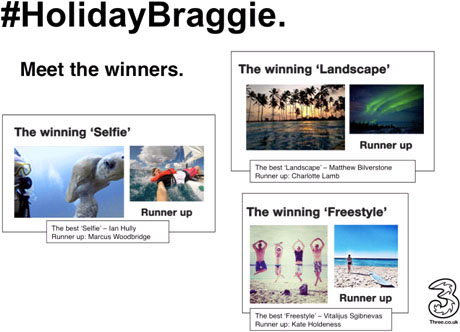
Boarding passes
We also used touchpoints that reached our customers when they were travelling on holiday, such as boarding passes.

Phase 2: Apology
We then turned our attention to potential new customers. The value we had offered our customers had 'inadvertently' caused a problem for people back home on other networks.
They were subject to a barrage of 'holiday spam' – the hot-dog legs, sunsets, cocktails, beach feet, plane wings – all the clichéd holiday images that clog up your social feeds every summer thanks to friends and family abroad. We have all been guilty in the past, but now the floodgates were open.
So we created a 'public apology' advertising campaign, apologizing on behalf of all our customers and encouraging them to 'please brag responsibly', in an attempt to limit the volume of holiday spam hitting the UK. Our choice of media mimicked a 'corporate crisis' with a public announcement TV ad, open letters in the national press, high-profile outdoor and apologies through social media. All were designed to fuel conversation and attract attention to the social-media crisis.

Television
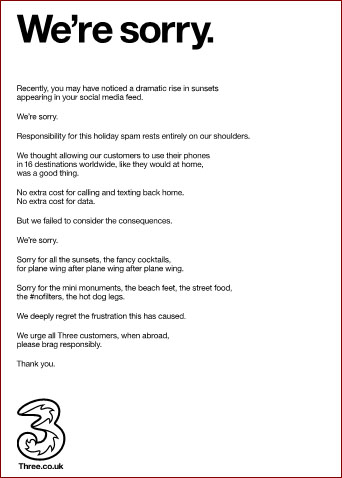
Full-page national press
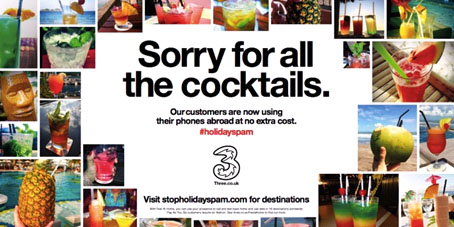
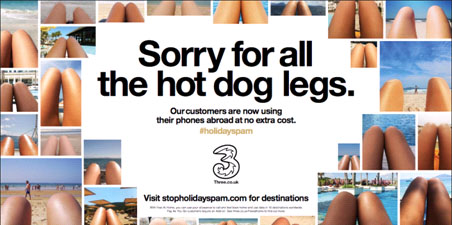
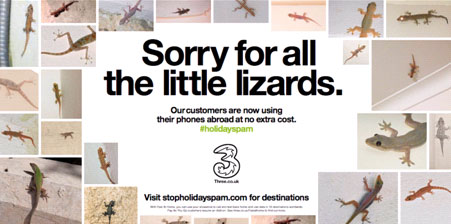

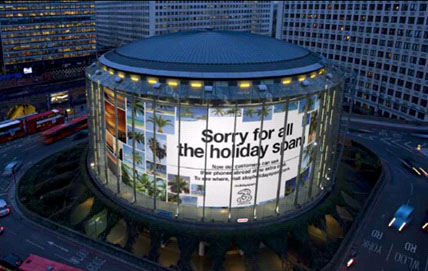
Outdoor
Our posters started social conversations with other brands and organizations.

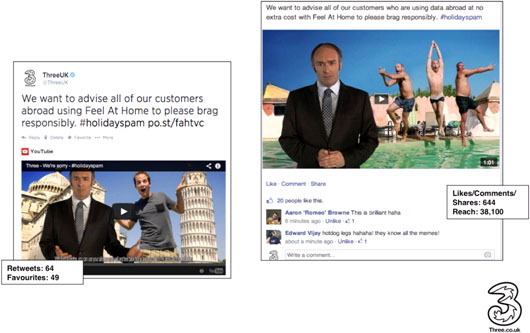
Social-media posts
Phase 3: Clean-up
When BP spilt all that oil, they tried to clean it up. In the same way, we decided that apologetic words would only go so far – we needed action to clean up the holiday spam that was ruining social-media feeds up and down the country.
We created a series of educational online films explaining what holiday spam was and offering guidance on how to avoid it. Each film highlighted a different type of holiday spam (hot-dog legs, plane wings etc) which fuelled further social-media conversation. Using live data analysis in social channels, the most successful films in terms of click-throughs were served more often.
We created an online hub (StopHolidaySpam.com) to offer people advice and warnings about where spam was forecast to come from next. It included a downloadable brochure to help people who were suffering from Travel Selfie Disorder (TSD).
We armed victims of holiday spam on social media with a hashtag to fight back with (#HolidaySpam) and encouraged them to 'tag a bragger'. We also gave some playful social media 'violation' warnings to send back to friends who posted holiday spam.
We went to the beaches of France to stop the onslaught of holiday spam in person. We even had an idea to encourage customers to please brag responsibly with the world's first 'wingvertising', but unfortunately we could not get an airline to run it in time!



Online and in-flight educational films

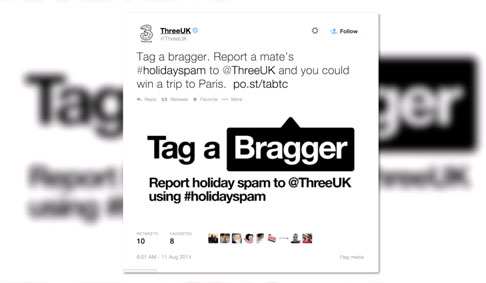
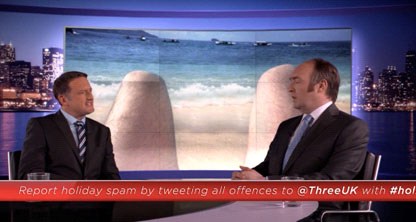
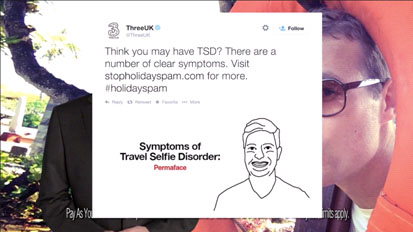


Social-media posts

No-braggie zones on French beaches
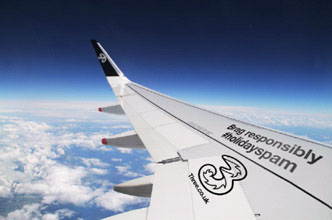
'Wingvertising'
Overall, the phasing of our media campaign is summarized below. Everything was designed to fuel the social-media crisis. A short TV burst over the opening weekend got people talking, posters raised awareness and everything fuelled the social-media conversation and visits to our hub StopHolidaySpam.com.
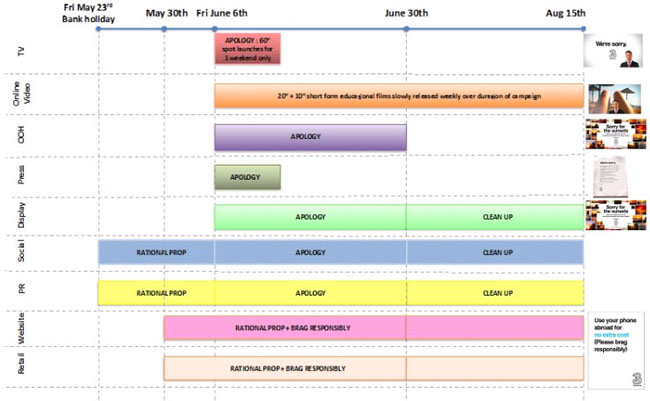
Social effects
In Phase 1 of the campaign, our #HolidayBraggie competition had:
- Over 5,000 entries received across Facebook, Twitter, and Instagram;
- A potential reach of 25.5 million across all social media channels;
- Over 3,400 hashtag #HolidayBraggie mentions from Twitter and Instagram;
- 78 direct contract orders from Three.co.uk, which was a nice bonus as it equates to around £30,000 in additional margin;
- A further reach of 17.1 million people through Facebook and Twitter by announcing new destinations during this phase of the campaign.
In Phase 2 of the campaign, #HolidaySpam had:
- A reach of 9.4 million across all social-media channels;
- Over 2,000 hashtag mentions in the opening weekend., with the campaign trending organically fuelled by our TV campaign;
- Over 75,000 engagements across Facebook and Twitter (likes, comments, shares and clicks);
- Over 1,000 further uses of #HolidaySpam through 'Tag a Bragger'
- 65% of those that used the hashtag going on to visit StopHolidaySpam.com (source: Brainjuicer);
- Two thirds of those that were aware of the campaign also being aware of the hashtag.
The campaign resulted in a 19% increase in conversation volume from June and, along with a 27% decline in customer complaints, shifted Three's net social sentiment from -12% in June to +7% in July (source: Beyond, July 2014).
Three were hailed as being on the pulse with the cultural zeitgeist in a number of social comments – demonstrating that Three know and celebrate how people really behave online on their mobiles today.


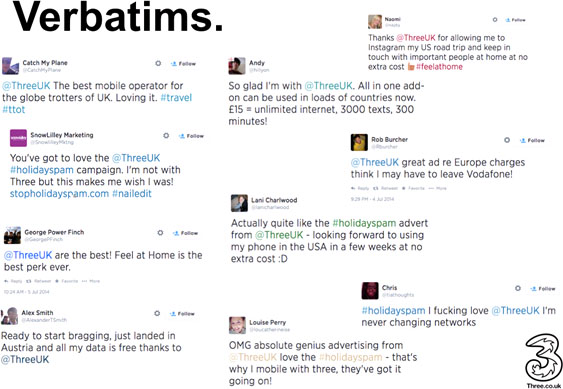
We achieved 1.162 million YouTube views and 585,000 visits to StopHolidaySpam.com. 45% of these visits were from people actively searching for the URL, suggesting the campaign was sticking in people's minds and generating word of mouth (source: Google Analytics). On StopHolidaySpam.com we generated 23,961 click-throughs to find out more about our offer and 1,648 direct clicks to buy a phone.
Business effects
Business effects have been removed due to confidentiality issues.
Lessons learned
Although the insight was unique to this case study, there are a few observations that we would like to share.
- We should always start from the business/brand objective and the associated target audience. The question should not be 'What should we do in social?', but instead 'What can social do for us?' Social should always be serving the brand and business.
- We should not be afraid to do the 'wrong' thing. On the face of it, apologizing for the best offer Three had ever had was madness. However, the confident boldness of our contrary stance created conversations. We had an interesting point of view, rather than simply the 'right' one, and that got us talked about rather than simply being ignored.
- We should use paid media to fuel owned and earned media. This is now an old adage, but it is a good principle to bear in mind with integrated campaigns.
- We should learn from soft launches. By seeing how customers took advantage of the offer in early 2014, we were able to pinpoint the specific behaviour that we should promote publicly. We observed that they were using 71 times more data, which became a key insight in developing the campaign.
- We should remember that people are people first and foremost – their natural human traits play out online. We found that people are inherently competitive and care what other people think of them (which leads them to send holiday braggies!).
- We should give people the tools to join in, rather than just tell them what to think. Our 'Tag a Bragger' hashtag and 'holiday spam violation warnings' armed people with the weapons to fight back against the onslaught.
- Finally, we should always look for the broader cultural relevance of a campaign, especially when it comes to social campaigns. What is the wider trend we are tapping into? Why will people care and connect with our campaign? How can we put a human and cultural truth at the heart of what we are doing?

